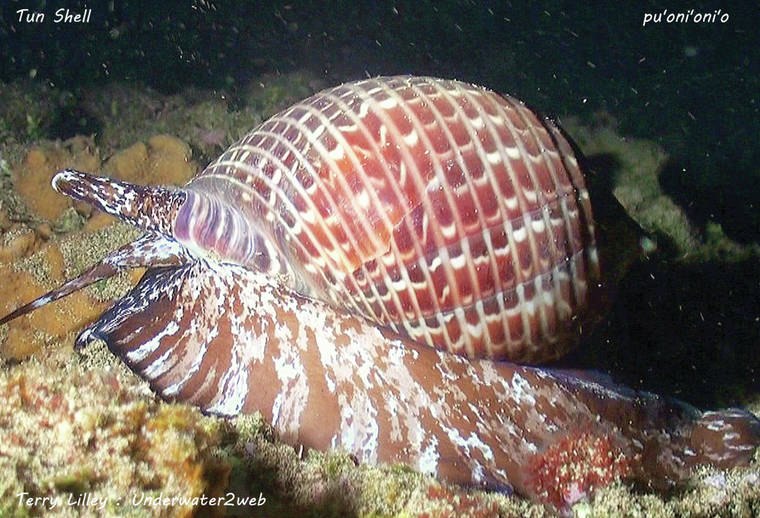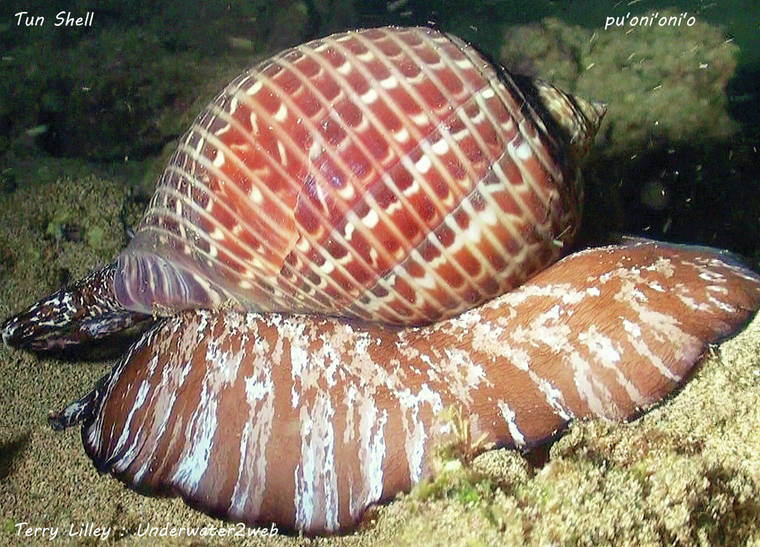The partridge tun is a very-unusual, giant Hawaiian marine snail that grows to 12 inches wide. What makes this colorful, golden-brown-and-tan snail unique is that it can’t pull into its shell like almost all other snails on earth. Its fleshy foot is three times larger than its thin, ribbed shell, so to protect itself in the day it fully buries in the sand so it can’t be easily found. Most all other marine shells like the cowry shell or cone shell can retract their soft bodies into their shell for protection so it does not get easily eaten by he‘e the octopus or other predators.
The partridge tun is a very-unusual, giant Hawaiian marine snail that grows to 12 inches wide. What makes this colorful, golden-brown-and-tan snail unique is that it can’t pull into its shell like almost all other snails on earth. Its fleshy foot is three times larger than its thin, ribbed shell, so to protect itself in the day it fully buries in the sand so it can’t be easily found. Most all other marine shells like the cowry shell or cone shell can retract their soft bodies into their shell for protection so it does not get easily eaten by he‘e the octopus or other predators.
Pu‘oni‘oni‘o only comes up out of the sand at night, when it crawls across the reef or sand looking for dinner, which is usually a sea cucumber, of which it eats whole in about 15 minutes, much like a snake would eat a whole mouse in about the same period of time. So many of our marine creatures eat other marine creatures, and the partridge tun sometimes gets eaten by hihimanu the eagle ray. The ray does not need to see the tun shell buried in the sand during the day because it can feel it by using electromagnetic sensors on the underside of its nose. Once it locates the live, buried shell, the ray digs it up by using its tough snout and flapping its fins. If you have been out snorkeling over a sandy area and seen large craters in the sand, they may have been made by an eagle ray digging up a tun shell for dinner.
Most people find pieces of the tun shell washed up on the beach, and rarely ever find an entire shell. This happens for two different reasons. The shells are very brittle and break up in the pounding surf, but they are also a favorite shell for hermit crabs to live in. Since the shell is so light, a hermit crab can move into the empty shell and use it for protection but still be able to crawl around much easier than if it moved into a thick, heavy, cowry shell.
Pu‘oni‘oni‘o empty shells are so popular out on the reef that I found a whole empty shell out night diving and saved it for my dive the next day. On my next dive I found a hermit crab in a heavy cone shell and laid the empty tun shell in front of the hermit crab. It instantly left its cone-shell home and moved into the tun shell. That only lasted a few seconds because a small octopus came out of its den and pulled the hermit crab out of the tun shell and crawled inside, then took off with its new home. Everybody loves tun shells.
You can see pu‘oni‘oni‘o in action in the movie “The World’s Guide To Hawaiian Reef Creatures” at underwater2web, and also have your kids check out many cool marine snails we find in our nonprofit Reef Guardians Hawai‘i Coral Reef Kids Camp.
•••
Terry Lilley is a marine biologist living in Hanalei and co-founder of Reef Guardians Hawai‘i, a nonprofit on a mission to provide education and resources to protect the coral reef. To donate, go to reefguardianshawaii.org.




